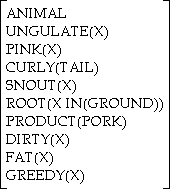- Meaningful Relations Between Words
- Lexical Relations
- Synonymy
beak bill couch sofa gift present - Antonymy
- contradictory
infinite finite mortal immortal - contrary:
good healthy not bad not sick not good not healthy bad sick
- contradictory
- Polysemy & Homonymy
- I can't go out now; I'm all tied up
- When the grenade went off under the cow Billy Bob was milking, he was left holding the bag.
- I don't own a single golf club
- Metaphor
- I'm all tied up.
- Bill was climbing the wall, when the idea suddenly hit her.
- Jane is his right hand.
- Victor is a pig/cow/snake/dog/fox
Buffy is a pig

- Synonymy
- Logical Relations
- Entailment
- Bill married Hilary. (Bill and Hilary are married? Bill and Hilary are married to _________ ?)
- Bill married Hilary and Hans. (Bill and Hilary are ________? )
- Buzzy shot the bear. (The bear is dead.)
- Contradiction
- a living corpse
- an unmarried bachelor
- an uneducated college professor (?)
- (Pre)supposition
- Have you stopped beating your wife?
- Are you seeing a psychiatrist?
- I'll get the Alka-seltzer.
- John knows that his car has been stolen.
- Entailment
- Lexical Relations
- Reference and Meaning
Frege's examples prove that semantics is conceptual and not perceptual
- The evening star
- The morning star
- The evening star
- Meaning, Concepts, and Properties
- Classical categories.
Members of a category must contain all the properties defining the
category.
- What about penguins and ostriches that don't fly?
- What about a robin that has lost both wings? Is it still a bird??
- Fuzzy Concepts.
While concepts themselves may be clear, the borders demarcating them
are seldom so.
- Where is the line drawn between a bird and a non-bird? Why is a penquin a bird? What about a bat?
- What is an animal? Are fish animals?
- Graded membership.
Categorial properties are not simply present or absent. Instead, a
member of a category may have varying degrees of a given property.
- A robin is the prototypical bird.
- What is a turkey?
- What is a penguin?
- What is a platypus?
- Classical categories.
Members of a category must contain all the properties defining the
category.
-
Types of meaning
• Linguistic Meaning is what we will be concerned about for the time being. This is the meaning of the words themselves.
• There is also the Speaker's Meaning, which may coincide with the linguistic meaning or may not (literal vs. non-literal).
• Even within Linguistic Meaning there can be variation: idolectical meaning vs. language meaning; regional and social dialectical meanings.
The semantic descriptions of words (definitions) contain three types of features:
- Category features assign the word to a semantic category, e.g. a bird belongs to the category [FOWL].
- Function features assign a usual state or activity to the word, e.g. a bird flies [FLY(X)] and builds nests [BUILD(X NEST)]
- Property features list the properties distinguishing the reference of the word, e.g. a bird has a beak [BEAKED(X)] and features [FEATHERED(X)]
- Conclusion
The semantic entry for the word for bird may be expressed as:
(The sub-X in [FOWLX] indicates that it is the agent (X-argument) in each of the other features.)
Words refer to things which belong to semantic categories, and every object or concept must belong to some category. Objects may belong to more than one category, but categories should be seen not as absolutes, but as a potential conglomerate of components, some number of which are necessary in some degree. The categories to which an object belongs may be written as semantic features in its semantic description, i.e. definition. The meaning of a word, therefore, is basically the sum of the features it possesses (which lead us to the category or categories to which it belongs).